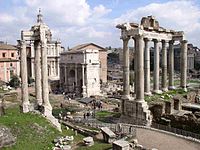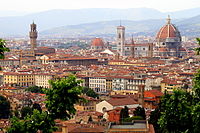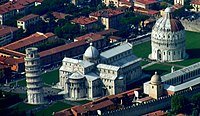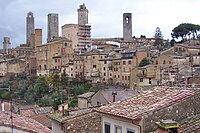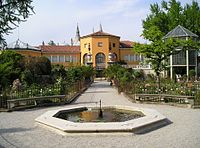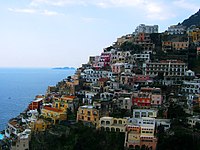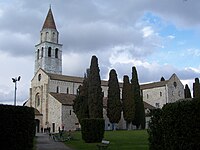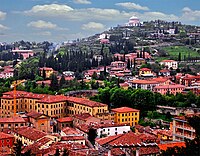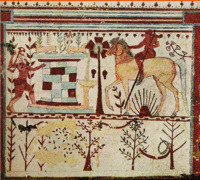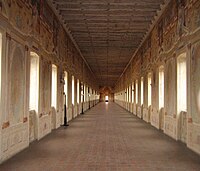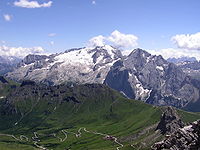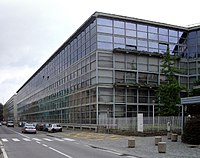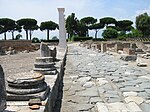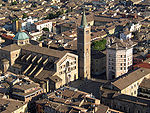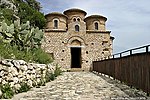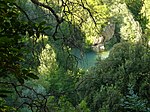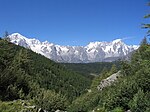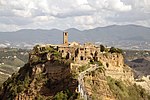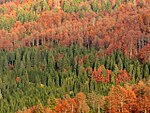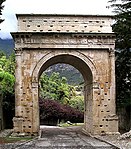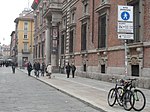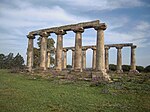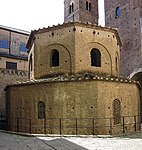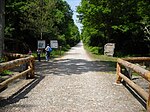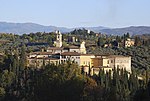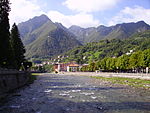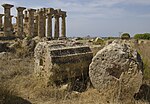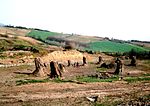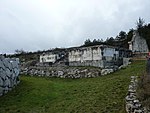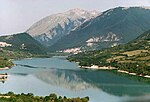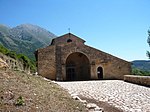World heritage in Italy
The world heritage in Italy (as of 2019) includes 55 UNESCO world heritage sites , including 50 world cultural heritage sites and five world natural heritage sites. Five of these sites are cross-border or transnational . Except for Molise and the Aosta Valley , all Italian regions have World Heritage Sites. Italy ratified the World Heritage Convention in 1978, and in 1979 the rock art in Valcamonica was the first World Heritage site to be included in the World Heritage List. The last World Heritage site to date was registered in 2019.
The UNESCO World Heritage Committee has already met twice in Italy: in 1983 in Florence and in 1997 in Naples .
World heritage sites
The following table lists the UNESCO World Heritage Sites in Italy in chronological order according to the year of their inclusion on the World Heritage List (K - cultural heritage, N - natural heritage, K / N - mixed, (R) - on the Red List of World Heritage in Danger ).
![]() Map with all coordinates of World Heritage Sites: OSM
Map with all coordinates of World Heritage Sites: OSM
| image | designation | year | Type | Ref. | description |
|---|---|---|---|---|---|
|
Valcamonica rock art ( location ) |
1979 | K | 94 | The first of the more than 140,000 rock carvings were made around 8,000 BC in the Epipalaeolithic . In their entirety, the images are excellent sources of both the history of the real and of mentality, as they depict topics relating to agriculture, navigation, hunting and magic and can be used to study changes . | |
|
Historic center of Rome, the extraterritorial sites of the Holy See in the city and Saint Paul Outside the Walls ( location ) |
1980 | K | 91 | The historical center of Rome , proposed in 1980, was supplemented by the Vatican possessions in 1984 and 1990, so that the center with a size of 1,446.2 hectares and a further 38.9 hectares, which are owned by the Holy See, are now under protection. In addition to the ancient sites, the heritage now also includes the churches of Santa Maria Maggiore , the Lateran Basilica and Saint Paul Outside the Walls or buildings such as the Cancelleria , the Palazzo Maffei Marescotti or the Palazzo di Propaganda Fide . | |
|
Church and Dominican monastery of Santa Maria delle Grazie in Milan with the Last Supper by Leonardo da Vinci ( location ) |
1980 | K | 93 | The church of Santa Maria delle Grazie was built in 1463 and later expanded by Bramante on behalf of Ludovico il Moro . Leonardo da Vinci completed The Last Supper in 1497 in the refectory of the monastery belonging to the church. The facility was bombed on August 16, 1943, making extensive reconstruction work necessary. | |
|
Historic center of Florence ( location ) |
1982 | K | 174 | In the center of Florence, founded on an Etruscan settlement, stands the cathedral of Santa Maria del Fiore , which was begun in the 13th century . The city's architecturally and historically significant expansion took place in the 15th century by master builders such as Filippo Brunelleschi and Leon Battista Alberti . | |
|
Venice and its lagoon ( location ) |
1987 | K | 394 | According to ICOMOS , the city of Venice , which is spread over 118 islands, and the lagoon had a geographical, historical and aesthetic unit, which, however, is exposed to a multitude of dangers. The area to be protected extends over 50,000 square kilometers and is both proof of man's struggle against the adversities of nature and evidence of intercultural exchange. Venice's architectural design is unparalleled. | |
|
The Piazza del Duomo in Pisa ( location ) |
1987 | K | 395 | The cathedral square in Pisa is usually called Piazza dei Miracoli (Square of Miracles), the ensemble of the cathedral , the leaning tower , the baptistery and the historical cemetery is one of the most famous in Italy in the world. | |
|
Historic center of San Gimignano ( location ) |
1990 | K | 550 | San Gimigniano is located on the Via Francigena in southern Tuscany. 14 of the former 72 towers are still preserved. They emerged in the conflict between Ghibellines and Guelphs and shaped the cityscape simply by their height of up to 50 meters. In addition to the largely preserved medieval architecture, the city also has high artistic frescoes, for example by Taddeo di Bartolo and Ghirlandaio . | |
|
The Sassi and the Park of the Rock Churches of Matera ( location ) |
1993 | K | 670 | There is evidence that Matera has been inhabited by people without interruption since the Paleolithic, making it one of the oldest places in human history. In Matera there is also a settlement carved into tuff , the so-called città sotterranea . Ceramic finds dating back to the early Iron Age were made there at a depth of around ten meters . The declared heritage also includes rock churches, most of which were built in the High Middle Ages. | |
|
Old town of Vicenza and Palladian villas in Veneto ( location ) |
1994 | K | 712 | The course of the streets of ancient Vicenza , which was founded either in the first or second century BC, is recognizable to the present day. Architecturally, the city and its surroundings are significant because of the work of Andrea Palladio , whose villa style was based on ancient traditions and has not only been copied across Europe. There are 23 buildings attributed to Palladio in Vicenza, including a basilica and the Teatro Olimpico . | |
|
Historic center of Siena ( location ) |
1995 | K | 717 | Siena emerged from an Etruscan settlement and gained great importance in the Middle Ages. The old town was built between the 12th and 15th centuries in Gothic style and influenced urban planning and art in Europe. One of the most important examples of Gothic architecture in Italy is the Santa Maria Assunta Cathedral . Construction began at the beginning of the 13th century and continued into the 14th century. The town's landmark, however, is the old town hall with the tower that defines the townscape. | |
|
Historic center of Naples ( location ) |
1995 | K | 726 | Neapolis , founded by Greek settlers near a commercial port at the beginning of the fifth century BC, is one of the oldest cities in Europe. Their buildings reflect various rulers: from the Hohenstaufen era, mainly religious buildings; the Castel Nuovo was significantly rebuilt under Alfonso I of Aragon, the Palazzo Reale was built under Spanish rule before Naples again became the capital of the newly founded Kingdom of Naples in the Peace of Vienna (1738) . | |
|
Crespi d'Adda ( location ) |
1995 | K | 730 | The textile manufacturer Cristoforo Benigno Crespi bought around one square kilometer of land on the Adda in order to build a plant for industrial cotton processing. Three years later he had the first houses built in a workers' settlement, which was expanded into a planned town in which the Crespi family also resided. After various changes of ownership, production is still there today, albeit at a reduced rate. | |
|
The renaissance old town of Ferrara and the Po Delta ( location ) |
1995 | K | 733 | The Renaissance old town of Ferrara was designed as the "ideal city" of the humanist era by the court architect Biagio Rossetti and is considered the first modern urban planning in the world. In the 15th and 16th centuries, the city became an intellectual and artistic center. The nearby Po Delta is an outstandingly planned cultural landscape that has retained its original shape. | |
|
Castel del Monte ( location ) |
1996 | K | 398 | The Castel del Monte is one of the most famous Staufer castles in Italy and was built at the time of Frederick II in the middle of the 13th century. The octagonal castle contains ancient , Islamic and Gothic elements. It is not known for what purpose and why the castle was built in an octagonal shape. | |
|
Trulli of Alberobello ( location ) |
1996 | K | 787 | Trulli are conical buildings made of white painted walls with characteristic limestone slabs , which are layered on top of one another without mortar in the form of a false vault and which are increasingly appearing in Apulia. But only in Alberobello do entire districts consist of trulli and thus form an exceptional example of folk architecture. | |
|
Early Christian buildings in Ravenna ( location ) |
1996 | K | 788 | Ravenna was the main residence of the Western Roman emperors from 402 to 476. Eight buildings date from this period and are of particular art historical importance. These include early Christian churches, baptisteries, mausoleums and mosaics. They display a great deal of artistry including a wonderful mix of Greco-Roman tradition, Christian iconography, and Oriental and Western styles. | |
|
Historic center of Pienza ( location ) |
1996 | K | 789 | The old town of the small town of Pienza bears witness to the urban planning concept of the Renaissance. From 1459, Pope Pius II had his hometown redesigned by the architect Bernardo Rossellino and thus made it look urban. It is worth highlighting several palaces and the Cathedral of Santa Maria Assunta , which mix elements from the Renaissance and Gothic. In 2004 the world heritage was expanded to include the surrounding valley. | |
|
18th century palace of Caserta with park, the Vanvitelli aqueduct and San Leucio complex ( location ) |
1997 | K | 549 | Charles III had the palace of Caserta north of Naples . Built according to the plans of Luigi Vanvitelli in the mid-18th century to compete with the Palace of Versailles and the Palacio Real . The baroque building surrounds a large garden. The San Leucio district and the Vanvitelli aqueduct , which supplied the facilities with water, are also part of the world heritage . | |
|
Residences of the Royal House of Savoy ( location ) |
1997 | K | 823 | The House of Savoy began a large series of construction projects in the royal seat of Turin and the surrounding region from 1562 to demonstrate the power of the ruling house. They are castles and other representative buildings that were designed as outstanding building complexes and embellished by the leading architects and artists of the time. | |
|
Padua Botanical Garden ( location ) |
1997 | K | 824 | The oldest botanical garden in the world, which is still in its original location, was laid out in 1545. It is known for its special collections and its historical structure. | |
|
Portovenere and Cinque Terre with the islands of Palmaria, Tino and Tinetto ( location ) |
1997 | K | 826 | The "five countries", as the Cinque Terre are translated, are a stretch of coast of the steep Ligurian coast. The cliffs and the surrounding landscape clearly show their influence on urban planning. The cultural landscape , which has existed for about a millennium, had a major influence on urban planning. | |
|
Modena Cathedral, Bell Tower and Piazza Grande ( location ) |
1997 | K | 827 | The Cathedral of Modena in the 12th century by Wiligelmo and Lanfranco in Romanesque style built. The church tower is the 88 meter high, so-called Ghirlandina , which was built in the Gothic style and can now be considered the city's landmark. The adjacent piazza is also part of the world heritage. | |
|
Archaeological sites of Pompeii, Herculaneum and Torre Annunziata ( location ) |
1997 | K | 829 | When Vesuvius erupted on August 24, 79 AD, it destroyed the two flourishing cities of Pompeii and Herculaneum and several villas of wealthy Romans in the vicinity. The excavations since the mid-18th century shed light on the lifestyle in the trading town of Pompeii, one of the best preserved ancient city ruins, and in the resort of Herculaneum, as well as the luxury of the Oplontis villa in Torre Annunziata . | |
|
Amalfi Coast ( location ) |
1997 | K | 830 | The costiera amalfitana is located on the west coast of Italy on the Gulf of Salerno and is an area of great architectural beauty and diverse nature. The coastal villages are a testament to man's adaptability with terraced vineyards and orchards on the slopes. The cathedral of Amalfi from the 10th century is architecturally significant . | |
|
Villa Romana del Casale ( location ) |
1997 | K | 832 | The Villa Romana del Casale is a late Roman villa near the city of Piazza Armerina . The structure is an important monument of Roman Sicily and famous for its floor mosaics. It is considered the most outstanding example of a Roman luxury villa , illustrating the prevailing social and economic structure of its time. The mosaics are exceptional in their artistic quality and ingenuity, as well as in their quantity. | |
|
Su Nuraxi di Barumini ( location ) |
1997 | K | 833 | Nuraghe are prehistoric and early historical towers of the Bonnanaro culture and the nuragic culture in Sardinia . The Su Nuraxi are best preserved . The complex at Barumini, which was expanded and strengthened in the first half of the 1st millennium, is the most beautiful and complete example of this remarkable form of prehistoric architecture. | |
|
Archaeological sites of Agrigento ( location ) |
1997 | K | 934 | The archaeological sites of Agrigento to the south of today's city center are among the most impressive archaeological sites in Sicily and have been surprisingly well preserved. Above all they show the remains of Akragas, one of the most important ancient Greek cities. The Doric temples, some of which are still very well preserved, bear witness to the size, power and cultural heyday of the city at that time and form one of the most outstanding monuments of Greek art and culture. | |
|
Archaeological site and patriarchal basilica of Aquileia ( location ) |
1998 | K | 825 | The Basilica of Santa Maria Assunta of Aquileia is an impressive building with extraordinary mosaic floors and played an important role in the evangelization of a large region of Central Europe. The not yet fully excavated parts of the archaeological site show one of the largest and richest cities of the early Roman Empire. | |
|
Historic center of Urbino ( location ) |
1998 | K | 828 | The hill town of Urbino experienced a great cultural boom in the 15th century, attracting artists and scientists from all over Italy and beyond, and influencing cultural developments elsewhere in Europe. Due to its economic and cultural stagnation since the 16th century, Urbino has retained its Renaissance appearance to a remarkable extent. | |
|
National Park Cilento and Vallo di Diano with the archaeological sites of Paestum and Elea and the Charterhouse of Padula ( location ) |
1998 | K | 842 | The second largest national park in Italy is located in the Cilento , a varied stretch of land with river valleys and cliffs with a diverse flora and fauna. The temples of the Greek colonies Paestum and Elea as well as a former Carthusian monastery are part of the world heritage . | |
|
Villa Adriana ( location ) |
1999 | K | 907 | The Villa Adriana or Hadrian's Villa was the summer residence and retirement home of the Roman emperor Hadrian . | |
|
Verona old town ( location ) |
2000 | K | 797 | The historic city of Verona was founded in the 1st century BC. Founded in BC, it flourished under the Scaligians in the 13th and 14th centuries and as part of the Republic of Venice in the 15th to 18th centuries. Verona has a remarkable number of monuments from ancient times, the Middle Ages and the Renaissance and represents an outstanding example of a military fortress. Particularly noteworthy are the Castelvecchio and the well-preserved arena . | |
|
Aeolian Islands ( location ) |
2000 | N | 908 | Lipari , Vulcano , Salina , Stromboli , Filicudi , Alicudi and Panarea with their volcanic landscapes are classic objects of the ongoing study of volcanology worldwide. Through their scientific exploration at least from the 18th century onwards, the islands have provided the textbooks of geology and volcanology with two types of eruptions (Vulcano-type and Stromboli-type) and thus played an important role in the education of all geoscientists for more than 200 years. They also offer a rich field for volcanological investigations into ongoing geological processes in the formation of landscapes. | |
|
Assisi, basilica and memorials of St. Francis ( location ) |
2000 | K | 990 | As the birthplace of St. Francis, Assisi has many buildings connected to the Franciscan order . The masterpieces of medieval art in Assisi, such as the basilica, one of the most senior Catholic places of worship with significant Renaissance paintings, influenced Italian and European art and architecture. | |
|
Villa d'Este, Tivoli ( location ) |
2001 | K | 1025 | Ippolito II. D'Este chose a former Benedictine monastery in Tivoli as the palace . This was enlarged and decorated with mannerist paintings. At the same time, one of the main works of Italian garden art was created with statues from the Renaissance and over 500 fountains , nymphas , water features , grottos and water basins as well as a water organ . The gardens were the model for many gardens in the age of Mannerism and Baroque . | |
|
Late baroque towns in Val di Noto ( location ) |
2002 | K | 1024 | The late baroque towns of the Val di Noto form a group of towns in the Val di Noto in southeastern Sicily that form a uniform ensemble of the late baroque . These include the cities of Catania , Caltagirone , Militello in Val di Catania , Modica , Noto , Palazzolo Acreide , Ragusa and Scicli . They offer an extensive example of the Sicilian baroque and have a largely uniform urban and architectural character. | |
|
Sacri Monti in Piedmont and Lombardy ( location ) |
2003 | K | 1068 | The nine Sacri Monti (Holy Mountains) of northern Italy are extensive chapels and other pilgrimage sites that were built on mountains and lakes in the late 16th and 17th centuries and each dedicated to certain aspects of the Christian faith. In addition to their symbolic and spiritual significance, they are of great beauty and well adapted to the landscape. They contain numerous works of art, such as paintings and sculptures. | |
|
Val d'Orcia ( location ) |
2004 | K | 1026 | The landscape of the Val d'Orcia is part of the agricultural hinterland of Siena, redesigned in the 14th and 15th centuries to reflect an idealized model of good governance and to create an aesthetically pleasing landscape. The landscape has a distinctive aesthetic with flat chalk plains and almost conical hills with fortified settlements. | |
|
Etruscan necropolis of Cerveteri and Tarquinia ( location ) |
2004 | K | 1158 | These two large Etruscan cemeteries in Lazio represent different types of burial practices from the 9th to the 1st centuries BC. And testify to the achievements of the Etruscan culture. Some of the graves are monumental, cut into the rock and crowned by impressive burial mounds. Many have carvings on the walls, others have wall paintings of outstanding quality. The necropolis near Cerveteri contains thousands of tombs that are laid out in urban areas with alleys, small squares and quarters. The Tarquinia necropolis contains 6,000 tombs carved into the rock. It is famous for its painted graves, the oldest of which date back to the 7th century BC. Chr. | |
|
Syracuse and the rock necropolis of Pantalica ( location ) |
2005 | K | 1200 | The necropolis of Pantalica is one of the great necropolis of Sicily and contains more than 5000 chamber tombs. Together with Syracuse , which is an example of excellent architectural achievement in various cultural aspects, it forms a unique collection of remarkable testimonies to Mediterranean cultures. The most important buildings in Syracuse include the Temple of Apollo , the catacombs and the cathedral . | |
|
Genoa: Le Strade Nuove and the Palazzi-dei-Rolli complex ( location ) |
2006 | K | 1211 | In the 16th and 17th centuries, when the Republic of Genoa was at its height, the Le Strade Nuove (The New Streets) and a system of patrician houses and sumptuous palaces in the Renaissance and Baroque styles called Palazzi dei Rolli were built. | |
|
Rhaetian Railway in the Albula / Bernina landscape ( location ) |
2008 | K | 1276 | The Albula and Bernina lines of the Rhaetian Railway connecting Thusis with the Italian town of Tirano . The lines were completed in 1904 and 1910 and are considered a technical masterpiece from the pioneering days of the railroad. The candidacy was drawn up together with Switzerland . | |
|
Mantua and Sabbioneta ( location ) |
2008 | K | 1287 | The two cities of Mantua and Sabbioneta show in different ways urban development and planning during the Renaissance. While Mantua with its Romanesque cathedral , the church of Sant'Andrea and the Palazzo Ducale has been expanded and renewed, Sabbioneta was built as an ideal city on behalf of Vespasiano Gonzaga and is considered the first autonomous city to be founded during the Renaissance. | |
|
Dolomites ( location ) |
2009 | N | 1237 | The nine sub-areas of the World Heritage Dolomites , a mountain range of the southern Limestone Alps , form a series of unique mountain landscapes of extraordinary beauty. The sublime, monumental and colorful landscapes of the Dolomites have always fascinated a large number of travelers and have been the source of numerous scientific and artistic interpretations. | |
|
Monte San Giorgio ( location ) |
2010 | N | 1090 | The 1097 m high mountain, located between the southern arms of Lake Lugano , is considered the most important site for fossils from the Central Triassic . Scientific excavations since 1924 have uncovered numerous fossils of fish , reptiles , crustaceans and insects . In 2010 the World Heritage site was expanded to include the southern part belonging to Italy. | |
|
The Lombards in Italy, places of power ( location ) |
2011 | K | 1318 | The sites testify to the high performance of the Lombards . The Lombard synthesis of architectural styles marks the transition from antiquity to the European Middle Ages, following on from the legacy of ancient Rome, from Christian spirituality, from Byzantine art and that of Germanic Northern Europe. Includes u. a. the grotto church of San Michele and Tempietto del Clitunno. | |
|
Prehistoric pile dwellings around the Alps ( location ) |
2011 | K | 1363 | 111 pile dwelling settlements from the period between 5000 and 500 BC were added to the list. 19 of them are in Italy, the rest in Germany, Austria, France, Slovenia and Switzerland. | |
|
Medici villas and gardens in Tuscany ( location ) |
2013 | K | 175 | Twelve villas and two pleasure gardens, which are located in Tuscany and were built between the 15th and 17th centuries, bear witness to the influence of the Medici family on European art and culture. | |
|
Etna ( location ) |
2013 | N | 1427 | The Etna is the highest on a Mediterranean island situated mountain and the most active volcano in the world. Due to its activity, Etna is easy to explore and therefore influenced volcanology , geophysics and other geosciences . | |
|
Wine-growing regions in Piedmont: Langhe, Roero and Monferrat ( location ) |
2014 | K | 1390 | The world heritage site comprises five wine-growing regions and a castle in the Langhe , Roero and Monferrat landscapes in Piedmont . | |
|
Arab-Norman Palermo and the cathedrals of Cefalù and Monreale ( location ) |
2015 | K | 1487 | The site includes nine civil and religious buildings from the era of the Norman Kingdom of Sicily (1130-1194): the Palazzo dei Normanni with the Cappella Palatina , the Castello della Zisa , the churches of San Giovanni degli Eremiti , Santa Maria dell'Ammiraglio and San Cataldo , the cathedral , the Ponte dell'Ammiraglio , as well as the cathedrals of Cefalú and Monreale . Together they are an example of the socio-cultural syncretism between Western, Islamic and Byzantine cultures on the island. | |
|
Old beech forests and primeval beech forests of the Carpathian Mountains and other regions of Europe ( location ) |
2017 | N | 1133 | Transnational World Heritage with Albania, Belgium, Bulgaria, Germany, Croatia, Austria, Romania, Slovenia, Slovakia, Spain and Ukraine. In Italy to beech forests belong in the Casentino Forest National Park , National Park of Abruzzo, Lazio and Molise , Monti Cimini , Natural Park Bracciano - Martignano , Pollino National Park and the Gargano National Park . | |
|
Venetian defense system of the 16th to 17th centuries: Stato da Terra - western Stato da Mar ( location ) |
2017 | K | 1533 | In Italy Palmanova , Bergamo and Peschiera del Garda belong to them. Other sites are in Croatia and Montenegro . The nominated sites in the Venice lagoon were not registered, but are already part of the “Venice and its lagoon” World Heritage.
|
|
|
Ivrea - industrial city of the 20th century ( location ) |
2018 | K | 1538 | Ivrea was strongly influenced by this after founding the Olivetti company in 1908. | |
|
The Prosecco Hills between Conegliano and Valdobbiadene ( location ) |
2019 | K | 1571 | Cultural landscape of prosecco cultivation in this region , which has been shaped by man for centuries for this purpose. Characteristic landscape elements are hills in the shape of the back of pigs, cultivation plots (ciglioni), forests, small villages and arable land in the rugged surroundings. |
Tentative list
The sites that are intended for nomination for inclusion in the World Heritage List are entered in the tentative list .
Current World Heritage candidates
As of 2019, there are 41 sites in the tentative list of Italy, the last entry was in 2019. The following table lists the sites in chronological order according to the year they were included in the tentative list.
![]() Map with all coordinates of current World Heritage candidates: OSM
Map with all coordinates of current World Heritage candidates: OSM
Former World Heritage candidates
These sites were previously on the tentative list, but were withdrawn or rejected by UNESCO. Sites that are included in other entries on the tentative list or that are part of world heritage sites are not taken into account here.
![]() Map with all coordinates of former World Heritage candidates: OSM
Map with all coordinates of former World Heritage candidates: OSM
| image | designation | year | Type | Ref. | description |
|---|---|---|---|---|---|
|
Alba Fucens ( location ) |
1982-1982 | K | Ruins of an ancient city | ||
|
Ascoli Piceno ( location ) |
1982-1982 | K | |||
|
Fortress of Bard ( Lage ) |
1982-1982 | K | |||
|
Brera, Milan ( location ) |
1982-1982 | K | Old town district of Milan | ||
| Ponds of Cagliari | 1982-1982 | ? | |||
| Santa Maria Novella train station, Florence | 1982-1982 | K | |||
| Gennargentu National Park | 1982-1982 | N | |||
|
Grotte di Castellana ( location ) |
1982-1982 | N | |||
| Valle d'Itria | 1982-1982 | K | |||
|
Locri ( location ) |
1982-1982 | K | Location of the ancient Greek city of Lokroi Epizephyrioi | ||
| Massafra | 1982-1982 | K | The municipality of Massafra in Apulia is known for its caves and the frescoed grotto churches. | ||
| Metapont | 1982-1982 | K | |||
| The island of Montecristo and its marine environment | 1982-1982 | N | |||
| Pisticci | 1982-1982 | K | |||
| Piazza Maggiore, Todi | 1982-1982 | K | Todi's main square , also called Piazza del Popolo | ||
| Historic center of Turin | 1982-1982 | K | The Turin Cathedral was a separate proposal on the tentative list from 1984-1994. In 1997 the residences of the Savoy royal family in and around Turin were included in the World Heritage List. | ||
|
Parco dell'Uccellina ( location ) |
1982-1982 | N | |||
| Arco thermal architecture | 1984-1984 | K | |||
| Faenza Cathedral | 1984-1984 | K | San Pietro Cathedral in Faenza | ||
| Santa Maria delle Carceri, Prato | 1984-1984 | K | |||
| Otranto | 1984-1985 | K | |||
| Albenga Baptistery | 1984-1996 | K | early Christian baptistery next to Albenga Cathedral | ||
| Castrum from Aosta | 1984-1996 | K | The city of Aosta was built by Augustus under the name Augusta Praetoria instead of an existing legion camp (castrum). The chessboard-like floor plan of the camp was adopted for the civil city and can still be seen in the cityscape of the old town. | ||
| Bosco Fontana Nature Reserve | 1984-1996 | K / N | |||
| Casamari Abbey | 1984-1996 | K | |||
| Cremona Baptistery | 1984-1996 | K | early Christian baptistery next to Cremona Cathedral | ||
| Fossanova Abbey | 1984-1996 | K | |||
| Galluzzo Monastery, Florence | 1984-1996 | K | Charterhouse (Monastery of the Carthusian Order ) in Florence | ||
| Milan - Ospedale Maggiore | 1984-1996 | K | from 1456 built hospital in Milan | ||
| Thermal architecture of Merano | 1984-1996 | K | |||
| Novara Baptistery | 1984-1996 | K | early Christian baptistery next to Novara Cathedral | ||
| Piero della Francesca - Siena, Firenze, Borgo San Sepolcro | 1984-1996 | K | The Renaissance painter Piero della Francesca worked in Siena , Florence and Sansepolcro .
Florence has been its own World Heritage Site since 1982, while Siena has been a World Heritage Site since 1995, Piero's birthplace, place of death and long-standing place of activity, Borgo San Sepolcro, today's Sansepolcro, however. |
||
| Sanctuary of Fortuna, Palestrina | 1984-1996 | K | Sanctuary and oracle of Fortuna Primigenia in the ancient city of Praeneste , today's Palestrina | ||
| Pomponesco | 1984-1996 | K | |||
| Pyrgi | 1984-1996 | K | Port of the Etruscan city of Caere | ||
| Revere and Bozzolo | 1984-1996 | K | includes the towns of Revere and Bozzolo in the province of Mantua in Lombardy . | ||
|
Segesta Archaeological Site ( location ) |
1984-1996 | K | ancient city of the Elymians in northwestern Sicily with a Doric temple | ||
| Stelvio National Park | 1984-1996 | N | |||
| Trani Cathedral | 1984-1996 | K | |||
| Castles and palaces of Trentino | 1984-1996 | K | included castles and palaces in the province of Trentino . | ||
| Tropea | 1984-1996 | K | |||
| Veji | 1984-1996 | K | |||
| Villas on Vesuvius | 1984-1996 | K | |||
| Giotto and Fra Angelico - Assisi and Cortona | 1984-1997 | K | Sites of the work of Giotto and Fra Angelico in Assisi and Cortona .
Assisi was declared a World Heritage Site in 2000 as the place of activity of St. Francis of Assisi . |
||
| Promontorio di Portofino | 1984-1999 | K | Peninsula in Liguria with the historic center of Camogli , the Abbey of San Fruttuoso and the Bay of Paraggi near Portofino | ||
| San Pellegrino Terme | 1984-1999 | K | |||
| Tempio Malatestiano | 1984-2005 | K | Rimini Cathedral | ||
| Selinunte Archaeological Park | 1987-1987 | K | In 1987 postponed by Unesco due to a lack of management plan | ||
| Ostia Antica, Portus Romae and Isola Sacra | 1987-1987 | K |
Ostia Antica , the harbor city of ancient Rome , with its port Portus and the front of the mouth of the Tiber lying Isola Sacra
Portus Romae was once again on the tentative list as a separate suggestion from 1996-2005. |
||
| Papal Residences of Anagni and Viterbo | 1994-1996 | K | Papal palaces from the 13th century in Anagni and Viterbo | ||
| Rock sanctuary of Olevano sul Tusciano | 1996-1997 | K | The Grotta di S. Michele is a stalactite cave with a single-nave chapel with three apses, in which wall paintings from the 10th and 11th centuries in the Byzantine-influenced style have been preserved. | ||
| Alghero | 1996-2005 | K | |||
| Bologna old town | 1996-2005 | K | Replaced in 2006 by a proposal that only includes the arcades. | ||
| Parks and villas of the Castelli Romani (Alban Mountains) | 1996-2005 | K | Parks and villas in the Castelli Romani area in the Alban Hills | ||
| Karst area: sources of Timavo | 1996-2005 | N | Italian part of a karst area in which the river Reka , which flows underground through the caves of Škocjan in Slovenia (World Heritage Ref. 390 ) , emerges again and flows into the Adriatic as Timavo . | ||
| Milan Cathedral | 1996-2005 | K | |||
| Fortresses of Montefeltro | 1996-2005 | K | Fortresses in the historic Montefeltro landscape in the Apennines | ||
| Bay of Naples | 1996-2005 | K | with Capri , Ischia and Procida | ||
| Oasis of Ninfa | 1996-2005 | K | The garden of Ninfa is a landscape park managed by the WWF in the area of the municipality of Cisterna di Latina . In the park are the ruins of the medieval city of Ninfa . | ||
| Spoleto and Tempietto sul Clitunno | 1996-2005 | K | Only the Basilica of San Salvatore in Spoleto and the Tempietto del Clitunno in Campello sul Clitunno were included in the World Heritage Site The Lombards in Italy, Places of Power (568 to 774 AD) (Ref. 1318 ) in 2011. | ||
| Cividale and the early centers of Lombard power in Italy | 1996-2011 | K | 333 | Only the Gastaldaga area and the episcopal complex were included in the World Heritage Site The Lombards in Italy, Places of Power (568 to 774 AD) (Ref. 1318 ) in 2011. | |
| Palermo, Botanical Garden and Monreale Complex | 1996-2011 | K | 363 | included the old town of Palermo , the Botanical Garden of Palermo and the cathedral and monastery complex of Monreale
Since 2015, seven buildings in Palermo in the Norman-Arabic-Byzantine style and the Cathedral of Monreale have been part of the World Heritage Arab-Norman Palermo and the cathedrals of Cefalù and Monreale (Ref. 1487 ). |
|
| Dunarobba fossil forest | 1997-1997 | N | Petrified forest in the Dunarobba hamlet of Avigliano Umbro | ||
| Samnite sanctuary of Pietrabbondante | 1997-2003 | K | Sanctuary of the Samnites in Pietrabbondante | ||
| Lake Garda coast | 1998-2003 | K | |||
| Rock settlements in Apulia | 1998-2005 | K | Cave architecture in Puglia | ||
| Cathedral and historic district of Cefalù | 1998-2005 | K | Only the Cathedral of Cefalù has been part of the Arab-Norman Palermo World Heritage since 2015 and the cathedrals of Cefalù and Monreale (Ref. 1487 ) | ||
| Gran Paradiso National Park | 1999-1999 | N | |||
| Abruzzo National Park | 2000-2000 | N | |||
| Romanesque culture ensembles in Abruzzo | 2002-2005 | K | Architecture of the Romanesque in the Abruzzo Apennines | ||
| Pontine archipelago | 2002-2005 | K | |||
| Coastline from Castellammare del Golfo to Trapani | 2002-2005 | K | Mediterranean coast between the towns of Castellammare del Golfo and Trapani , with the mountain town of Erice , the island of Mozia and the Egadi islands
Mozia has been on the tentative list as a single suggestion since 2006 (Ref. 2029 ) |
||
| Gargano promontory | 2002-2005 | K / N | with Monte Sant'Angelo , Isole Tremiti and the Foresta Umbra | ||
| Alps, a) Western Alps, b) Dolomites, c) Eastern Alps | 2006-2009 | N | 2026 | In 2009 the Dolomites were declared World Heritage Dolomites (Ref. 1237 ). | |
| Valtellina | 2006–2012 | K | 5001 | The proposal Grape Landscapes: Langhe, Roero, Monferrato and Valtellina was postponed in 2012 to be revised. The revised proposal with wine-growing areas in the Langhe , Roero and Monferrat landscapes in Piedmont was included in the World Heritage List in 2014 (Ref. 1390 ). The Valtellina was no longer included. |
Web links
- Italy on the UNESCO World Heritage Center website.
- Beni Italiani Unesco Italian World Heritage List on the website of the Associazione Beni Italiani Patrimonio Mondiale Unesco
Individual evidence
- ↑ Italy. In: whc.unesco.org. UNESCO World Heritage Center, accessed July 15, 2019 .
- ↑ Sessions . whc.unesco.org, accessed April 9, 2014
- ^ Tentative list of Italy. In: whc.unesco.org. UNESCO World Heritage Center, accessed March 18, 2018 .
- ^ Former Tentative Sites of Italy. In: World Heritage Site. Retrieved July 22, 2017 (English).


